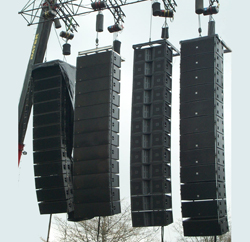
I’ve made a business decision about this, and have decided not to name names, which allows me to have a lot more fun, and probably avoid lawsuits.
For the record, I have never done any of the stuff I am about to discuss.
People of lamentable character suborned me at a convention once, plied me with champagne, and told me things that rocked my faith in human nature (and “scientific” shootouts) to the core.
Though it may seem like I actually did these things, rest assured I am innocent – it is merely writer’s artifice.
We’ll assume these experiences relate to loudspeaker system shootouts – anything said here would apply to other, less extensive, events.
Remember, the goal here is better sound for a one-off event.
These are not necessarily the best practices for the longevity of the kit, but they rule on any given day.
Loudspeaker Cabling: Neutrik NL4’s and NL8’s are now the industry standard, which means that you will be using 13 gauge (metric) wire.
As the standard goal is to get as much copper into the shortest run possible, it would be great if we could jam 12 or even 10 gauge into these pins, but the bigger gauges won’t fit without a ton of futzing.
If you want to try that, take the heavier gauge cable, and once you’ve stripped the end, do not twist the strands – leave them straight, as that is your only chance to get them to fit.
Flow solder (Cardas silver preferred) onto the wires, and then file or cut the end until it fits the little bitty Neutrik socket. This method will vary with the vintage of Neutrik you have, of course.
For the correct gauge, the 13 gauge, tin the receiving socket with the silver solder, flow some onto the stripped end, and then jam that end into the socket, heat it up, and flow as much more solder as possible into the join.
The more the better, and the hell with how it looks. Believe me, if you do it right, that sucker ain’t coming apart. More importantly, it will not sound the same. The difference is not subtle – most noticeably in the bass and the mid-bass. Unless someone (unlikely) opens up your sockets, they’ll never know. If they had a clue, they’d be doing this themselves.
Also, have different cable lengths for different situations. Start with a set of 24 footers for ground support situations on smaller rigs, and make the jumpers the exact length they need to be. Shorter, as always, is better.
Avoid couplers – they don’t help the sound. Make up custom runs for situations where you need the extra length. If at all possible (remember, we are not touring here, we are doing shootouts) have your loudspeaker cables terminate directly at the amps – no patch panels.
Add all this stuff up, and you will have a significant improvement in sound quality over identical kit where no advantages were taken.
Signal Cabling: Mogami everywhere, and use the top line Neutrik XLR’s with the gold pins. Canare is OK too, especially if you are going into icky RF environments, but overall Mogami has the edge in sound quality.
Find the best cable fabricator in town and have him/her do the work – do not even think of buying this stuff pre-made. Have some 50 and 100 hundred footers made up as well, for main send runs. Do not use snakes or multicores for your main sends – use the same stuff that’s in your racks.
Electrical Cabling: Think gauge and size. If possible, have some 50 or 60 amp breakers available in one of your distros, for situations when there are big feeds available.
Have appropriate feeder and terminations for this distro, and use it when you can. Amps love those big breakers – the audible improvement is frankly (sorry) shocking.
